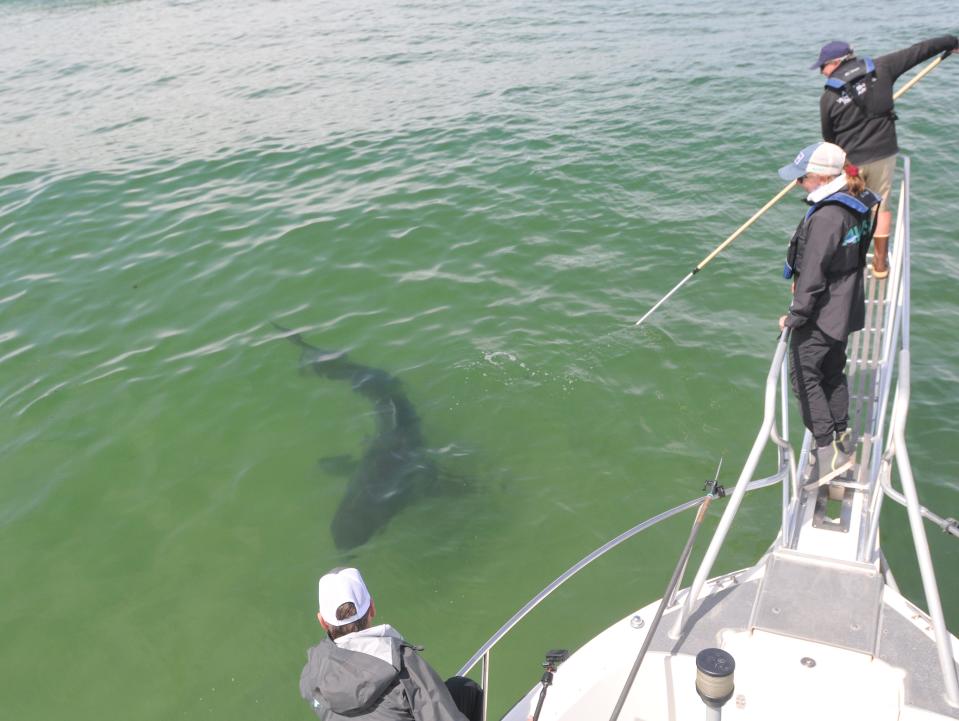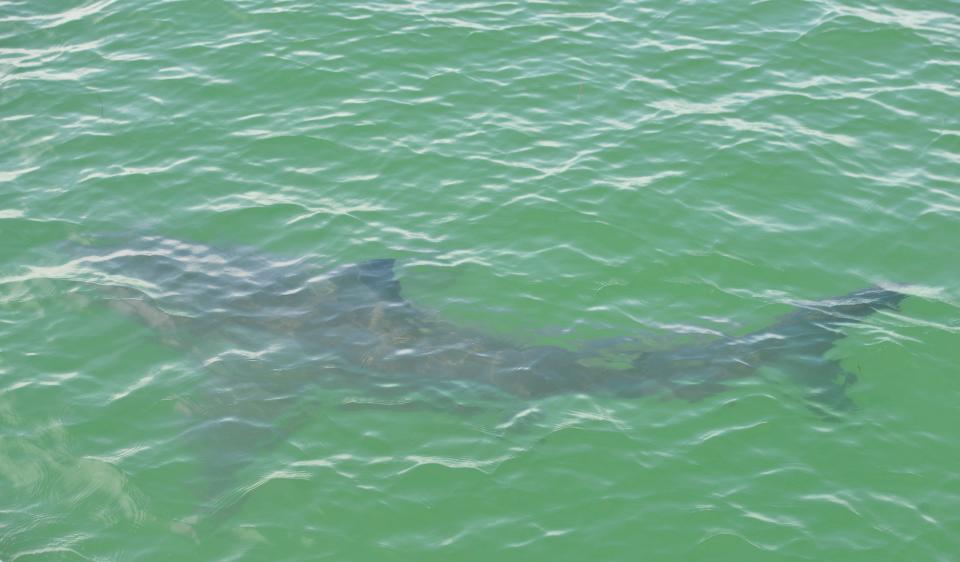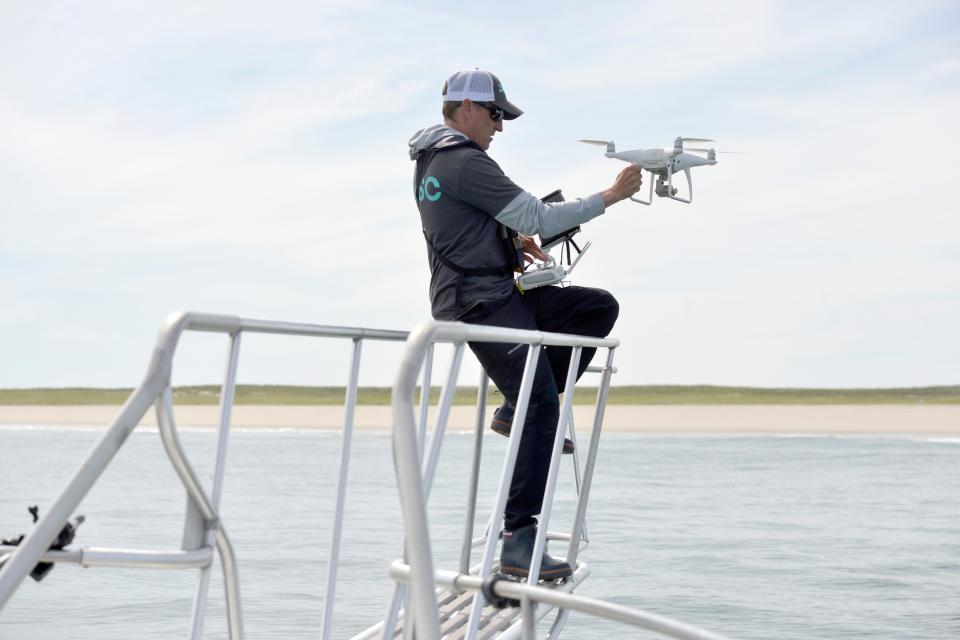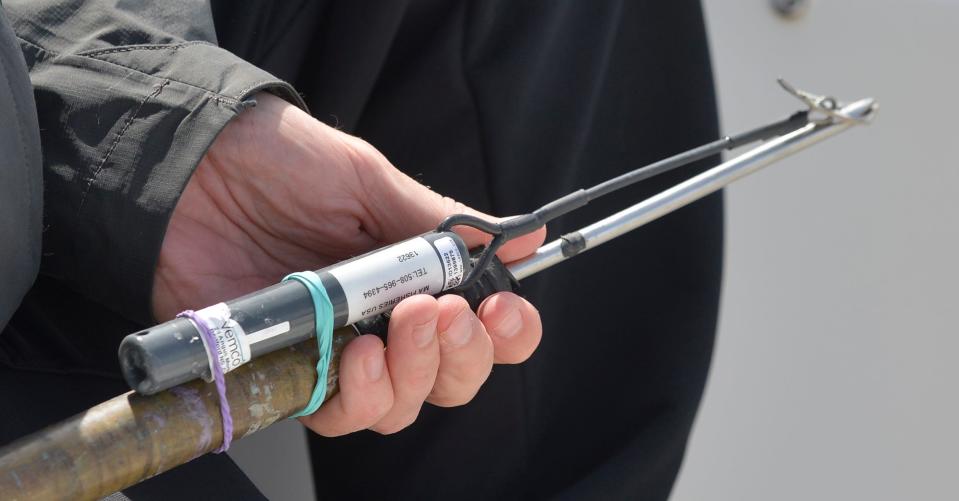'Find us a fish.' Unraveling the mysteries of Cape Cod's great white shark population
ATLANTIC OCEAN OFF MONOMOY — On board the Aleutian Dream, a 24-foot research vessel for the Atlantic White Shark Conservancy during the white shark season here, state Division of Marine Fisheries researcher Gregory Skomal late on Monday morning squinted at the patchy blue sky.
"Find us a fish, Wayne," he said, watching from under the bill of his Massachusetts Marine Fisheries ball cap as a small plane moved against clouds splashed overhead like spilled milk.
The hopeful appeal for a great white shark sighting, directed toward the pilot of the Citabria NI592X aircraft, Wayne Davis, could have been uttered by any one of the four research team members — also including volunteer research assistant and Conservancy board member Brian Hanson, Conservancy research coordinator Ashleigh Novak, and Aleutian Dream skipper John King — waiting aboard the boat as it rose and fell with the ocean like a fishing bobbin just offshore of Monomoy Island.

It was more than three hours into a white shark tagging and research expedition that left at 8:30 a.m. from Ryder's Cove Landing in North Chatham. Davis had spent that time flying back and forth along the coast between Nauset Beach and Monomoy, looking for sharks, but dark and opaque waters and early morning cloud cover made the task difficult.
An initial sighting just beyond North Beach Island at 8:58 had, for a few exhilarating moments, raised everyone's hopes as King sent the boat nearly flying over the waves to catch up with the shark. But it was to no avail, as the animal slipped away into black water before the team could reach it.
And so, the arrival of noon found them all waiting.
A waiting game.
This is the reality of the Atlantic white shark research being done off Cape Cod, now recognized as a world hotspot for the protected species.
"There's a ton of waiting. It's not like it's non-stop action," Hanson revealed.
The team, which was sharing the hunt on Monday with two shark tour outfits that had boats on the water and planes circling, was anxious for some shark action. Usually, they head out two or three times a week during the season from about mid-June to November, but frequent bad weather this summer has kept them off the water more than they'd like.
It's also been a bit disappointing on the tagging front. The research in large part relies on finding untagged white sharks and attaching acoustic and camera tags to collect fine-scale data about the sharks' environment and behavior.
"We haven't tagged a shark in several trips," Hanson said.

As of Monday morning, the team had successfully tagged only five white sharks since their expeditions began in June.
"We'll have years where we'll tag 25 to 35," Hanson said, "so we've got work to do."
Low shark activity on Cape could be related to fewer seals - maybe
For some reason, Skomal said, "it has been a slow year" for the Cape's white sharks, though the usual peak time is only just beginning, so there's some hope still for a good tagging season.
It's possible the low shark activity so far could have something to do with the seals the sharks like to eat, Skomal speculated, noting that some of the plane pilots earlier in the summer reported seeing fewer seals than usual. But there are "so many factors" that could be driving the slow season, he stressed, and it will take some data analysis as well as a better understanding of what the seals are doing.
Finding the sharks is not an easy task, even though a recent population study estimated that at least 800 individual white sharks visited the waters off Cape Cod over a four-year period, and the team has tagged more than 300 of them.
"Everybody gets the impression immediately there are 800 sharks out here (at the same time). That's not the case," said Skomal.
The sharks come and go, some just stopping by and then heading elsewhere, some sticking around for weeks. Some come back year after year, and others are only occasional visitors.
It's the scientists' job to understand them better, most importantly to learn the fine details of their comings and goings and minute-to-minute, even second-to-second predatory behavior. The goal is to use that knowledge to inform public safety and management policy.
If anyone's going to unravel the mysteries of the local white shark population, it'll be this research team, said Hanson, noting, "arguably the best scientific research that's being done is being done right here."
It starts with the tagging, though, and as they awaited a sighting on Monday, Skomal admitted, "I'm kind of anxious to get tags out."
'Just a shadow in the water.'
The sharks are difficult to spot from the deck of a boat, which is the reason they use a spotter pilot. From their vantage point, "literally, the sharks are just a shadow in the water. They're hard to see," said Skomal, whose book about the work, "Chasing Shadows," was just released in July.

During their outing Monday, Hanson deployed the team's DGI Phantom Pro 4 Version 2 drone a few times in hopes of spotting a shark. It's one of Novak's favorite tools.
"With the drone, it's amazing. We can cover so much area and there's a lot of great data that comes from using a drone," she said.
As the research coordinator, it's her job to record myriad observations, like wind speed, wave height, and cloud cover. When the team is in pursuit of a shark, she records everything from the initial sighting time, to the number associated with any newly deployed tags, what time they're deployed, and even how many photos and videos are taken.
"It's to basically paint a really clear picture of everything to jog our memories. Some days are really busy and it all blurs together," she said.

From zero to two in 20 minutes.
Speaking of busy, things finally got going for the team on Monday about half past noon, when a shark was spotted nearby.
At 12:33 they were hot on its tail. Skomal dipped a painter's pole with a video camera affixed to the end into the water and got the requisite recording of the shark while Hanson took photos and Novak dropped a hydrophone over the side of the boat to determine if the shark was previously tagged.
Finding no tag, Hanson helped Skomal switch his video pole for the tagging pole with its sharpened tip. By 12:38, the new tag was deployed, and the researchers let out a round of cheers, high fives, and exclamations about the beauty of the shark, estimated to be about 11 feet in length.
They had little time to soak in their success before a second untagged shark was sighted at 12:47. Again, the small deck became a flurry of activity as Davis deftly maneuvered the boat through tight turns to keep it alongside the animal. This shark, estimated at about 9 feet, was gregarious, staying close to the surface and even airing its dorsal and caudal fins — something that "you don't get to see that much," Hanson said.
The shark was tagged at 12:53 and was gone by 1. Again, cheers and high fives, and immediately the researchers began discussing the encounter as if reviewing the play-by-play of an exciting football game.
A repeat encounter, thanks to shark tour boat.
It wasn't the end of the team's shark encounters Monday, either, as a third shark was soon sighted not far away by one of Captain Cullen Lundholm's Cape Star Charters shark-tour boats. Usually, the research team hangs back to allow the charters to view sharks they are the first to get to. It's out of a sense of mutual respect and community out on the water, where Skomal said "everyone knows everybody."
Hanson explained the team has shared the waters more and more frequently with chartered shark tours.
"With the exposure and the knowledge about what we have here and the uniqueness of it in the world, it's grown in popularity," he said.
On Monday, the researchers were invited to come get a look. The shark turned out to be one the team tagged on Aug. 15 last year, a shark named Major Bro Dude. This time around, the scientists observed the shark had a fresh scar on its head, still pink and healing, and they took a new video to add to the shark's dossier in their database.
'All it takes is one.' A successful day on the water.
Skomal said he never gets tired of the work.
"All it takes is one. It fires you right up," he said. "It just requires patience."
The team has a record of six taggings in one day. The way this summer has gone, though, Skomal was more than satisfied with Monday's results.
"It wasn't non-stop action, but it was a successful day," he said as King powered the vessel back through Chatham's south inlet just past 3. "I'm happy with it."
Plus, there are still several weeks for more outings. He's hoping September and October are good months.
Heather McCarron writes about climate change, environment, energy, science and the natural world. Reach her at hmccarron@capecodonline.com, or follow her on Twitter @HMcCarron_CCT
Thanks to our subscribers, who help make this coverage possible. If you are not a subscriber, please consider supporting quality local journalism with a Cape Cod Times subscription. Here are our subscription plans.
This article originally appeared on Cape Cod Times: Here's how shark researchers keep track of Cape Cod's great whites

